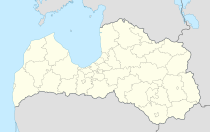Mežotne
| Mežotne ( German : Mesothen) | ||
|---|---|---|
 Help on coat of arms |
|
|
| Basic data | ||
| State : |
|
|
| Landscape: | Semgallia ( Latvian : Zemgale ) | |
| Administrative district : | Bauskas novads | |
| Coordinates : | 56 ° 26 ' N , 24 ° 3' E | |
| Residents : | 49 (Jun 3, 2015) | |
| Area : | ||
| Population density : | ||
| Height : | 28 m | |
| Website: | www.mezotne.lv | |
| Post Code: | ||
| ISO code: | ||
| Mesothen Castle, view from the banks of the Lielupe | ||
Mežotne (German: Mesothen ) is a place in Latvia about 10 kilometers west of Bauska (German: Bauske ) and about 40 kilometers south of the capital Riga (Latvian: Rīga ). It is located in the historic landscape Semgallen (Latvian: Zemgale ) on the left bank of the Lielupe (German: Courland Aa ) near the border with Lithuania .
history
At the end of the 10th century, a castle was built on one of the two hills on the banks of the Lielupe. The place appears as "Medsuna" on an Arabic map from 1154. In 1220 the castle of the Zemgaller rebels was besieged and taken by the Brothers of the Sword . The newly appointed Bishop of Selien resided here from 1225 to 1251. After his defeat in 1236 in the Battle of Schaulen ( Lithuanian Šiauliai ) the order was united with the Teutonic Order and the area came to the German Order.
The last master of the order Gotthard Kettler led the area in 1561 as the secular duchy of Courland and Semgallia under Polish suzerainty. After the Kettler dynasty died out in 1737, Ernst Johann von Biron came to power. After the third partition of Poland in 1795, the city became Russian.
Attractions
- Landscape park on the banks of the Lielupe
- The classicist palace was designed by the Russian court architect Giacomo Quarenghi (1744–1817) for Charlotte von Lieven , governess of the children of Alexander and Constantine of Tsar Paul I , and built from 1797 to 1802. Charlotte received land and money for this building out of gratitude from Catherine the Great , mother of Tsar Paul. Mesothen Castle was inhabited by the Lieven family until 1921 and expropriated as part of the agricultural reform. After being destroyed in various ways, for example in 1919 and 1944, it was restored between 1958 and 1996 and is now used by the Latvian government as a representative building. A hotel has also been set up in some areas, and tours of the castle are possible all year round.
- Castle ruins
literature
- Hans Feldmann , Heinz von zur Mühlen (ed.): Baltic historical local dictionary, part 2: Latvia (southern Livonia and Courland). Böhlau, Cologne 1990, ISBN 3-412-06889-6 , pp. 391-392.
- Astrīda Iltnere (ed.): Latvijas Pagasti, Enciklopēdija. Preses Nams, Riga 2002, ISBN 9984-00-436-8 .
Footnotes
- ↑ Hans Feldmann, Heinz von zur Mühlen (ed.): Baltic historical local dictionary, part 2: Latvia (southern Livland and Courland). Böhlau, Cologne 1990, p. 391.

